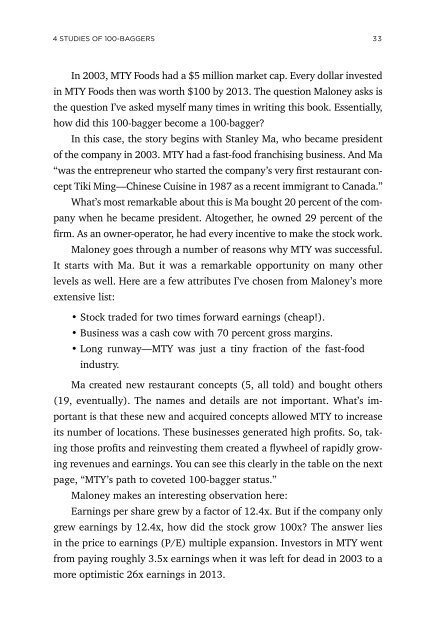Create successful ePaper yourself
Turn your PDF publications into a flip-book with our unique Google optimized e-Paper software.
4 STUDIES OF 100-BAGGERS 33<br />
In 2003, MTY Foods had a $5 million market cap. Every dollar invested<br />
in MTY Foods then was worth $100 by 2013. The question Maloney asks is<br />
the question I’ve asked myself many times in writing this book. Essentially,<br />
how did this 100-bagger become a 100-bagger?<br />
In this case, the story begins with Stanley Ma, who became president<br />
of the company in 2003. MTY had a fast-food franchising business. And Ma<br />
“was the entrepreneur who started the company’s very first restaurant concept<br />
Tiki Ming—Chinese Cuisine in 1987 as a recent immigrant to Canada.”<br />
What’s most remarkable about this is Ma bought 20 percent of the company<br />
when he became president. Altogether, he owned 29 percent of the<br />
firm. As an owner-operator, he had every incentive to make the stock work.<br />
Maloney goes through a number of reasons why MTY was successful.<br />
It starts with Ma. But it was a remarkable opportunity on many other<br />
levels as well. Here are a few attributes I’ve chosen from Maloney’s more<br />
extensive list:<br />
• Stock traded for two times forward earnings (cheap!).<br />
• Business was a cash cow with 70 percent gross margins.<br />
• Long runway—MTY was just a tiny fraction of the fast-food<br />
industry.<br />
Ma created new restaurant concepts (5, all told) and bought others<br />
(19, eventually). The names and details are not important. What’s important<br />
is that these new and acquired concepts allowed MTY to increase<br />
its number of locations. These businesses generated high profits. So, taking<br />
those profits and reinvesting them created a flywheel of rapidly growing<br />
revenues and earnings. You can see this clearly in the table on the next<br />
page, “MTY’s path to coveted 100-bagger status.”<br />
Maloney makes an interesting observation here:<br />
Earnings per share grew by a factor of 12.4x. But if the company only<br />
grew earnings by 12.4x, how did the stock grow 100x? The answer lies<br />
in the price to earnings (P/E) multiple expansion. Investors in MTY went<br />
from paying roughly 3.5x earnings when it was left for dead in 2003 to a<br />
more optimistic 26x earnings in 2013.


